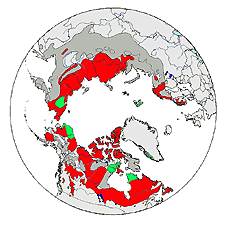- European are growing more vegetables. But how much of that is heirlooms?
- Canadian boffins grow wild potatoes for the leaves.
- Chinese wasp going to roast Italy’s chestnuts.
- The genetics of swine geography. Or is it the geography of swine genetics?
- The diversity of sauces.
- Cooking Flipper.
- Genetically engineered brewer’s yeast + cellulose-eating bacterium + biomass = methyl halides.
- Wild sheep runs wild in Cyrpus.
- “It can be planted in farms because it does not compete for resources with corn, coffee or bananas and acts as a nitrogen-fixing agent in the soil. The mpingo is also considered a good luck tree by the Chagga people who live on the slopes of the Mt. Kilimanjaro.”
Cats and dogs and maize: A Darwinian view
The Rough Guide To Evolution lists the entire content (with linky goodness) of the current early edition of the Proceedings of the National Academies of Sciences of the USA. As Mark Pallen notes, it “is chock full of articles on evolution from a recent colloquium”. Two that we’ll be reading over the weekend are:
- From wild animals to domestic pets, an evolutionary view of domestication, and
- Tracking footprints of maize domestication and evidence for a massive selective sweep on chromosome 10.
Who says we don’t know how to have fun round here?
Reindeer game up
The species Rangifer tarandus is divided into seven subspecies, but all are in trouble, according to a survey of their status published in a recent paper in Global Change Biology. We’re talking about the animals that are usually called reindeer in Europe and caribou in North America. All across their circum-polar range their populations are undergoing an unprecedented synchronous decline (red denotes herds in decline in the map below, which I hacked from the BBC article quoted below, green indicates those on the increase and dark grey means no data is available).

One subspecies — R. t. tarandus — comprises the semi-domestic and wild reindeer that live across northern Scandinavia and Russia and are so important to the Sami people and others. Here’s one of the authors quoted by the BBC on the causes of the decline:
“If global climate change and industrial development continue at the current pace, caribou and reindeer populations will continue to decline in abundance,” says Vors.
“Currently, climate change is most important for Arctic caribou and reindeer, while anthropogenic landscape change is most important for non-migratory woodland caribou.”
Interestingly, reindeer were recently re-introduced to Britain after a gap of 800 years. I guess their long-term future there must be in question.
Test your domestication knowledge
Kris’s Archaeology Blog at About.com:Archaeology has a challenging quiz about domestication. I got 15/20. You?
Nibbles: Tameness, Grass evolution, Baobab leaves, Cloning, Svalbard
- The roots of tameness.
- The roots of “grain endosperm texture.”
- The roots of drought tolerance in baobab.
- The roots of the difference between mitosis and meiosis.
- The roots of Svalbard.